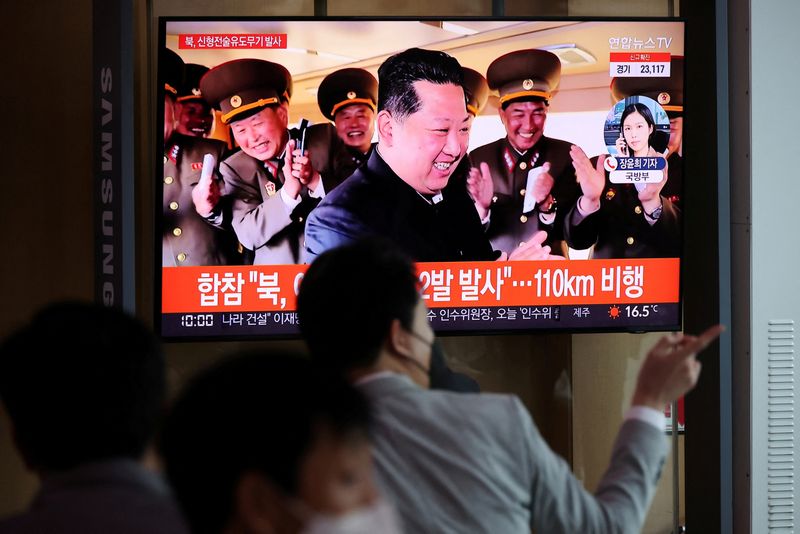Analysis-S.Korea doubles down on risky ‘Kill Chain’ plans to counter N.Korea nuclear threat
2022.07.26 02:51

FILE PHOTO: People watch a television broadcasting a news report on North Korea’s new type of tactical guided weapon test, at a railway station in Seoul, South Korea, April 17, 2022. REUTERS/Kim Hong-Ji/File Photo
By Josh Smith
SEOUL (Reuters) – South Korea is pouring resources into its strategy of deterring any North Korean nuclear attack by preparing for preemptive strikes if necessary, a strategy some experts say may exacerbate their arms race and risks miscalculation during a conflict.
South Korean President Yoon Suk-yeol, who took office in May, has publicly given new emphasis to the so-called “Kill Chain” system to counter a North Korean nuclear attack.
First developed a decade ago as North Korea ramped up its nuclear development, Kill Chain calls for preemptive strikes against the North’s missiles and possibly its senior leadership if an imminent attack is detected.
The system is a logical but highly risky and potentially unreliable way to try to counter North Korea’s nuclear threat, some experts and former officials say.
The implicit threat against North Korean leader Kim Jong Un is particularly destabilising, said Ankit Panda of the U.S.-based Carnegie Endowment for International Peace.
“I can see why leadership decapitation is tempting for South Korea, but threatening to kill the leadership of a nuclear-armed state is uniquely dangerous,” he said.
Jeffrey Lewis, a missile researcher at the James Martin Center for Nonproliferation Studies (CNS), called the plans “the most plausible route to a nuclear war on the Korean Peninsula.”
“This is the *military* plan that is most likely to succeed…” he said in a post on Twitter (NYSE:TWTR). “But it is also the option most likely to create uncontrollable escalation dynamics and start a nuclear war.”
South Korea’s Ministry of Defense did not respond to a request for comment on such concerns.
Yoon has previously said boosting the system is vital to making sure North Korea never launches an attack in the first place.
GROWING ARSENAL
This month, Yoon’s administration announced the creation of a Strategic Command by 2024 to oversee preemptive and retaliatory strike strategies. It includes a growing arsenal of ballistic missiles, F-35A stealth fighters and new submarines, which have been displayed in increasingly frequent drills.
South Korea is also seeking to develop its own satellites and other technology to detect North Korean targets independently from the United States.
But some experts say it is doubtful a preemptive strike could accomplish its goal.
North Korea in recent months has tested hypersonic missiles and missiles it says could carry tactical nuclear weapons, narrowing the time Seoul would have to respond to a pending attack.
“Kim has ample reason to believe that he can employ his nuclear weapons in a limited way and still survive,” Panda said.
A focus on decapitation strikes, meanwhile, may encourage Kim to adopt more dangerous command and control practices in a crisis, such as delegating nuclear authority so North Korea’s weapons can be used even if he is killed, Panda added.
U.S. ALLIANCE
At the root of South Korea’s strategy is a hedge against U.S. abandonment, European defence researchers Ian Bowers and Henrik Stalhane Hiim said in an academic report last year. “Its deterrent effect, no matter how uncertain, acts as a short-term stopgap if the United States abandons South Korea.”
Those concerns were heightened when then-President Donald Trump demanded Seoul pay billions of dollars more to support U.S. troops on the peninsula, and raised the prospect he could withdraw them.
The U.S. deploys around 28,500 troops on the peninsula and retains wartime operational control over the allied forces.
Park Cheol-kyun, who worked on international policy at South Korea’s Defense Ministry until May, said developing such capabilities didn’t necessarily reflect worries about U.S. commitments.
The new Strategic Command would involve a new operating system and new command structure, bringing “synergy” to the weapons used in the Kill Chain and related systems to enhance deterrent and response capabilities, he told Reuters.
An inconvenient fact for South Koreans wanting to display independent bravado to the North is that any preemptive strike would have to be done in consultation with the United States, a former senior U.S. official with knowledge of the situation said.
“To conduct a preemptive strike would not be an act of self defence, and by definition this would fall under the category of an Alliance decision,” the former official said. Firing unprovoked on North Korea would be a “major violation” of the Armistice Agreement in force since the 1950-1953 Korean War ended without an official peace treaty, the official added.
Lt. Colonel Martin Meiners, a Pentagon spokesman, declined to comment on the future deployment of military assets or military planning with South Korea, but said decisions on alliance force posture will be made bilaterally.
“While the United States remains committed to a diplomatic approach, we will continue to take all necessary measures to ensure the security of the United States and our allies,” he said.
Self defence is a fundamental principle that includes preemptive strikes if necessary, Mark Esper, a former U.S. secretary of defence under Trump, told Reuters.
“If we had clear intelligence that North Korea was going to launch a nuclear attack on Seoul, that would be a scenario that certainly a preemptive strike might be warranted,” he said.








